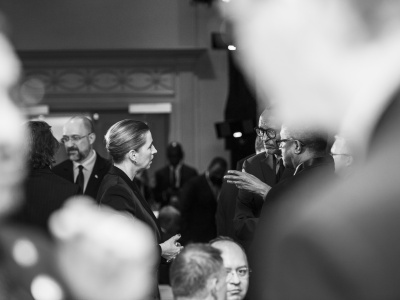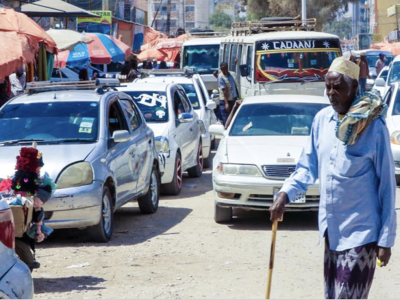
Through the looking glass: Global Europe in partner countries

Authors
Two years into the implementation of the NDICI-Global Europe and 18 months after the launch of the Global Gateway, what are the main practical changes in partner countries?
This page is also available in French.
The new Global Europe instrument and its guiding principles, as well as the Global Gateway strategy, have arguably brought about significant changes for the EU and its member states. They have transformed the way they engage in development cooperation, including through the Team Europe approach and a stronger framing around geopolitical ambitions and economic interests. Yet, as convincing as they might sound in Brussels, these changes take time to materialise and are not always well understood in partner countries.
We have looked at Kenya and Cameroon as good examples to understand the main implications of these new EU frameworks for and in partner countries and to assess how changes in the EU’s policy discourse and funding setup have affected the situation on the ground.
Both countries are important and like-minded EU partners as well as key contributors to regional stability in their respective areas. While they are lower-middle-income countries, they have different development trajectories and national contexts, including in their relationship with the EU, which helps to comprehend how the EU frameworks affect different countries.
Different contexts, different relations with the EU
The relations of Cameroon and Kenya with the EU have historically been framed by successive EU-ACP partnership agreements. As such, both countries have been affected – albeit differently – by the changes of the NDICI-Global Europe, especially by the budgetisation of the European Development Fund (EDF). The end of the principle of co-management and of the National Authorising Officer (NAO)’s role, which were predominant in the previous development cooperation relationship, has been another development with significant impact.
The end of EDF has been felt hard in Cameroon and has triggered a need for institutional adjustments and a rethinking of the role and place of the NAO. The EU remains an important donor, with France and Germany being the only two member states with a bilateral cooperation portfolio.
In Kenya, where the NAO’s role wasn’t so central, the EU is just one player among many (some twenty EU member states are present, as well as many bilateral and multilateral organisations). The context is more competitive. The relationship goes beyond aid, and there is a stronger match on areas and topics of mutual interests, including a stronger focus on green investments.
For both countries, the EU remains one of the largest trading partners, and the partnership increasingly focuses on trade issues. Recently, the EU and Kenya concluded negotiations for an Economic Partnership Agreement with strong sustainability provisions. Cameroon was the first country in Central Africa to sign the interim regional economic partnership with the EU in 2007, but its implementation still faces difficulties. The nature of the relationship and the role and weight of the EU as a donor and trading partner explain at least in part why and how European policies are perceived differently.

Communication is more than PR
The new Global Europe instrument is known by many stakeholders in Cameroon and Kenya and so is the end of the EDF, but the details and potential impacts are still unclear for them. It is still difficult for European actors in the field to communicate clearly about new EU initiatives, instruments and processes on which they are themselves just starting to grasp.
There is a strong need for more information sharing towards partners, including governments, civil society, local authorities and the private sector. Some communication efforts, such as the regional workshop on Global Gateway, organised in Cameroon in January 2023, were cited as good examples as they raised both awareness and interest at a high level.
However, no amount of communication will save the day without a tangible impact. Improved communication and information-sharing must come with swift actions on the ground. The ability to deliver fast on the promises made and expectations raised by the Global Gateway in particular will be crucial for the EU’s credibility.
Competition is a two-way street
Our research in both countries shows that NDICI-Global Europe has brought a level of unpredictability for – and competition between – partner countries. While the former EDF guaranteed a certain level of funding for individual partner countries, the flexibility built in NDICI-Global Europe also brings more uncertainty.
Furthermore, as recently pointed out by the European Court of Auditors, the application of the aid allocation formulas remains unclear. As a result, some interviewees expressed a sentiment of abandonment with the end of the EDF and the loss of something that guided the relationship for decades. Others pointed out that African countries were now being put in competition for funding, especially at the regional level, where bankable projects supported by the EFSD+ will be awarded on a ‘first come, first served’ basis.
In countries where multiple international actors are present, the EU needs to be able to present a real, attractive offer that brings up its added value and demonstrates impact.
Competition, however, is a two-way street. The EU is in increased competition with other international actors, like Russia and China, but also other emerging powers like Turkey. Past ECDPM research has pointed out that from partners’ perspectives, working with different geopolitical powers is a balancing act, for instance, in terms of alignment in the case of UNGA votes on Ukraine.
However, it would be a misconception to assume that African countries simply try to balance between the West, China and Russia. Partners don’t necessarily want to choose between donors but take from each one what is in their best interest. Particularly in countries where multiple international actors are present, the EU needs to be able to present a real, attractive offer that brings up its added value and demonstrates impact.
Our upcoming paper will delve deeper into the analysis of these two case studies. Overall, against the backdrop of growing geopolitical competition, the stronger push for EU visibility and the advancement of its interests and values aren’t necessarily perceived as a priority for – and in the interest of – partner countries. Going forward, it will thus be crucial to explain better the political objectives and practical implications of the changes sought by the EU while paying more attention to local perceptions and listening more to what partner countries want.





